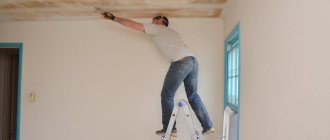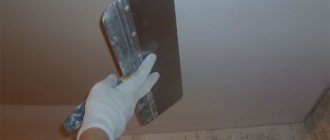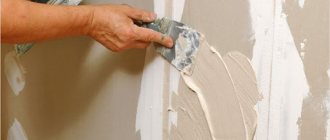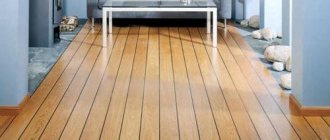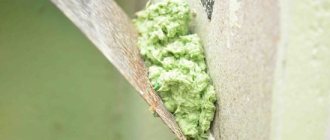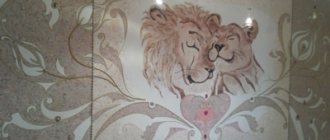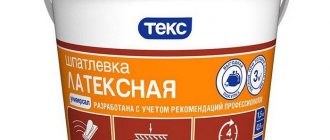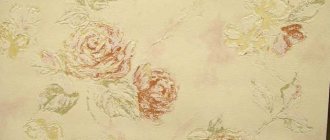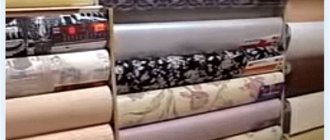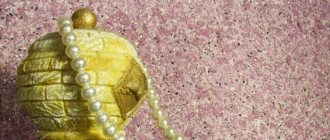How to choose the right concrete putties for interior work and for concrete walls
Concrete putties today are presented on the market in a wide variety and are used to protect and repair the base. The concrete surface is quite dense, but under the influence of external negative factors and time it tends to become deformed and become covered with a network of cracks. To avoid this effect and significantly extend the life of the concrete surface, it is protected with various compounds, one of which is putty.
- Restoration of the monolith, elimination of defects and protection from further destruction.
- Heat/sound insulation of the room.
- Leveling the surface before finishing.
- Reliable protection of concrete from various aggressive influences (both outside and indoors).
There are different putties for concrete - there are both universal compositions and special substances designed to perform a specific function. When choosing, you should focus on operating conditions, main tasks, features of the concrete surface, etc. But there are some requirements that all types of putties must meet.
- Complete drying time can vary from 4 hours to 5 days (it all depends on the specific type of substance).
- Waterproofing of concrete surface is about 98%.
- Frost resistance – up to 35 freeze/thaw cycles.
- The time for using the dry composition after it has been diluted according to the instructions is about 2 hours.
Regardless of which putty you choose for concrete walls, it is important to pay attention only to high-quality products from well-known manufacturers, who guarantee that the composition meets all requirements and provides detailed instructions for its use.
Types and characteristics
A reliable solution with a paste-like consistency, used for work on leveling surfaces - putty on concrete and for floors. The substance is universal in application; the treated building structures can be further subjected to finishing construction stages, which include applying paint or gluing wallpaper. The suspension consists of a filler and binding material. Components of excipients can be:
- chalk;
- barite;
- talc;
- pigment materials (ochre, zinc white);
- film former
Structures made of monolithic concrete are constantly exposed to mechanical influence, exposure to moisture in the form of groundwater and precipitation, and chemical exposure to special detergents (for floor care). To choose a specific type of material for surface treatment, the positive and negative characteristics of the mixture are studied. To reliably protect and level the surfaces of concrete products, the putty must have the following qualities:
The moisture resistance of the building material ensures strength and long service life.
- high adhesion;
- coating strength;
- moisture resistance;
- environmental friendliness;
- fire safety;
- long service life.
The created water barrier made from putty allows you to avoid installing special waterproofing from other materials.
Basic putty
This type of product is used for the primary treatment of severe surface defects. This concrete putty creates a thick initial layer, which, after drying and sanding with a trowel or sandpaper, is covered with several more treatments. The mixture is offered on the market in powder form, which is diluted with water until it reaches an elastic and moderately liquid state.
Finishing mixtures
After the base treatment has dried, the finishing layer is applied. Putty for a concrete floor or wall has the main purpose of creating smooth and even surfaces. These substances create a thin protective layer on the polished concrete surface. The design thickness of the putty layer is indicated on the packaging container of the mixture, which, unlike base products, should not be large.
Universal
This putty has a dual purpose - it can be used both at the initial stages of processing concrete products and during finishing work. Using the product, working layers of different thicknesses are created. A significant disadvantage of mixtures is the high cost of the product. In addition, highly specialized putties have the best end result of their use. These mixtures are also classified according to the base material:
- gypsum;
- cement;
- oil;
- varnish;
- polymer;
- acrylic;
- based on glue.
Gypsum putty
The main component of the powder solution is gypsum. The peculiarity of the mixture is that it can be used in buildings with any moisture level. And also a coating of such a substance promotes the natural process of moisture removal. The main advantages of putty:
- The mixture can be used on plastered surfaces.
- Has high thermal insulation abilities.
- The product is fireproof.
- Fast drying time.
- Environmentally safe.
- Good value for money.
Gypsum products are not used for external finishing, as they are not resistant to temperature changes.
- Promotes corrosion processes of metals.
- Susceptible to mechanical deformation.
- Does not tolerate temperature changes.
- Not used for external work.
- Afraid of moisture.
Cement
Puttying of concrete walls is most often done using such a mixture. The main component of the suspension is cement grade M400 or M500. The main advantages are water resistance and the ability to withstand moisture. The disadvantages include:
- Shrinkage of the putty layer. After the main treatment has dried, additional treatment is required.
- Inelasticity of a substance.
- After some time, the treated surface cracks.
- Doesn't apply well to a level surface.
- When it comes into contact with wooden structures, it increases in volume.
- Labor-intensive application process.
Latex
The main application is the processing of plasterboard structures; for concrete surfaces it is used for finishing plaster. The suspension is available on the market as a ready-to-use product, it is easy to use and soft. When processing surfaces, the thickness of the applied layer should be limited to 3 mm, and when the treated structures dry, drafts should not be allowed in the room.
Acrylic putty
A universal product, used for interior and facade work, mainly used for the finishing stage. The mixture is applied in a small layer; it acts as a means for decorating the surface of the ceilings. Main characteristics of the material:
- strength;
- elasticity;
- water resistance;
- frost resistance.
Polymer
Main characteristics of the material:
- elasticity;
- low consumption during work;
- high price.
Popular brands of polymer putties on the domestic market are AXTON, UNIS.
Varieties
Puttying of concrete surfaces can be carried out using various compositions, which are classified according to several criteria. Craftsmen usually select materials according to the order of application - starting, finishing, universal. The starting composition is used to eliminate defects and smooth out sharp transitions. Finishing putties are useful for leveling the surface for finishing. Universal views can be used in any format.
Types of putty for concrete according to composition:
- Cement mixtures are very popular, suitable for indoor/outdoor use. The main advantage is low cost, the disadvantage is shrinkage, which can lead to surface deformation and the appearance of defects.
- Gypsum compositions - used for interior work, are not suitable for exterior finishing and where there is high humidity.
- Acrylic putties are universal compounds that are suitable for any application conditions and different types of substrate.
- Epoxy - demonstrate increased strength and drying speed, but have the only drawback in the form of high cost.
According to the degree of readiness of concrete putties, there are:
- Dry mixtures - before use, the composition must be diluted with water according to the instructions. To mix a high-quality solution, it is advisable to use a drill with a special mixer attachment. Beginning craftsmen are not always able to mix putty correctly.
- Ready-made mixtures - they can be used immediately after opening the package. Putties are usually easy to apply and good for beginners, but are more expensive.
Types of putties
As a rule, when working with concrete, the following types of putties are used:
- Cement. This is the most popular type of mixture in question. Its basis is cement, most often grade M-400 or M-500. The positive side is good water resistance. The negative aspects include the lack of elasticity and, as a result, the appearance of cracks after some time due to shrinkage. This concrete putty is used for finishing walls outside the building, rooms with high humidity and working with concrete floors.
- Plaster. The basis of this material is gypsum. Due to the gypsum mixture, natural circulation of moisture occurs. Positive features include good thermal insulation, fire resistance, and environmental friendliness. The disadvantage is fragility. This mixture is used for interior finishing. It is not recommended to use this type of putty in rooms with high humidity (bathroom, shower, swimming pool).
- Acrylic. The basis here is acrylic. This is a universal putty, it is suitable for both external and internal work. Due to the good appearance of the finished surface, acrylic mixture is often used for finishing ceilings without subsequent painting.
To increase the adhesive properties of the working surface, it is recommended to treat the surface with primer before applying putty. In our case, when working with concrete, it is better to use concrete contact. However, when choosing a primer, you should pay attention to what kind of work: internal or external, it is intended.
Types of putty mixtures
Depending on the purpose, mixtures of different compositions are used. At the final stage of puttying, polymer and acrylic mixtures, as well as cement or gypsum putties, are used. Each composition has its own disadvantages and advantages. To find out which finishing putty is better , let's look at the main mixtures in more detail.
Cement composition
The cement option is popular due to its ease of use and low cost. It is used for finishing surfaces in rooms with high humidity - kitchen, bathroom or toilet. In addition, it is used before painting in entrances and for finishing building facades.
The cement composition is moisture resistant, gives the surface durability and strength when exposed to external factors.
Among the disadvantages are the possibility of cracks appearing, as well as shrinkage of the mixture after drying if the technology is not followed.
Attention! Grinding of cement putty is carried out until it dries completely. The dried coating is difficult to mechanically influence.
Gypsum putty
Using gypsum putty, a uniform white surface is created that can mask surface imperfections. It is recommended to use before gluing thin textured wallpaper with a fine structure, or to create a perfectly flat surface .
Attention! The gypsum composition dries in about two hours, depending on the manufacturer, and must be applied within approximately 30 minutes after mixing. Otherwise, the mixture loses its original qualities and becomes unsuitable for work. This applies to quick-drying compounds.
It is recommended to use gypsum putty in dry, heated rooms - bedrooms, corridors and rooms where you plan to apply a decorative coating.
Due to low waterproofing, the scope of application of the material is limited. However, such mixtures are characterized by affordable cost and ease of use.
Polymer option
The composition is prepared in the form of a ready-to-use mixture, which is the best option for people with minimal experience in carrying out repair work. Polymer putty only needs to be thoroughly mixed before use. Apply a thin layer to the prepared surface. Thanks to the composition, a smooth, uniform plane is created. Among the disadvantages is the high cost. Treating a large room will cost a lot of money. Thanks to the composition, the mixture adheres perfectly to the surface.
The super-finish version is distinguished by the presence of the finest particles in the composition , due to which it is used for artistic decoration when delicate decoration is required.
The polymer material is characterized by high plasticity and moisture resistance. The appearance of cracks is excluded, which is the reason for the long service life of the finish.
Application
The quality of the work performed depends not only on two elements: the choice of putty material and the correct application.
How to choose the right putty?
When purchasing a mixture, the following criteria should be considered:
- adhesiveness – the quality of surface gluing;
- type of surface – concrete, wood, stone;
- percentage of moisture resistance;
- vapor permeability is a good process of moisture circulation.
If the properties of the solution indicated by the manufacturer on the packaging and your requirements for the material coincide, this means that you have made the right choice.
Application technology
Puttying concrete walls and floors consists of 5 stages:
Stage 1 – work with the concrete base
- remove the old coating and widen the cracks with a drill;
- clean the surface from dust, dirt, grease and other unwanted substances;
- cover the cracks on the concrete floor or walls with a cement solution and let it dry.
Return to contents
Stage 2 – priming the concrete surface
- additional cleaning;
- Apply two coats of primer.
Return to contents
Stage 3 – kneading
- prepare a ready-made mixture for puttying or prepare it yourself, according to the proportions on the package;
- optimal proportions 1:5 (powder: water);
- to improve properties, you can add sawdust or chalk;
- apply within 3-4 hours after mixing.
Return to contents
Stage 4 – application
- the mixture should be thrown onto the surface and spread with a spatula;
- use reinforcing mesh for even greater strength;
- apply a second coat after the first has dried;
- complete hardening - after 24 hours or more (depending on the depth of the cracks).
Return to contents
Stage 5 – eliminating irregularities with sandpaper
The best putty manufacturers
A rating of popular and well-known brands of building materials manufacturers will help you choose a putty. The names of brands and manufacturers were selected based on the following criteria:
- Pot life time of the finished composition before lumps form.
- Drying time of the layer. The quick-drying composition will reduce the time required for repair work.
- Grain size.
- Terms of Use.
- What building materials can be puttied.
You should choose putty based on the individual properties and characteristics of the materials.
The leaders among them are Vetonit KR, Knauf Uniflot, Danogips, Axton, Semin Sem Joint, Prospectors, Pufas.
Starting
A popular and in demand starting mixture is Vetonit LR. Used on all types of substrates, easy to apply, affordable, reliable and durable. It is made on a lime base. Other rating leaders:
- Bergauf with Glatte cement mixture, consumption per 1 m2 is about 1 kg of dry powder with a layer of 1 mm. After 4 hours you can sand with sandpaper.
- “Volma standard” – permissible thickness up to 8 mm, consumption 0.8 kg, drying speed 2 hours.
- “Osnovit Ekonsilk” is a representative of gypsum mixtures, the permissible application layer is up to 2 cm, in the presence of a reinforced mesh - up to 7 cm.
The Kilto brand offers a polymer starting putty with a grain size of 0.5 mm. Acceptable thickness is 3-5 mm.
Putty Vetonit LR
Glatte cement putty
Putty “Volma Standard”
Putty “Osnovit Ekonsilk”
Kilto brand starter putty
Finishing
Finishing putty for wallpaper is the final stage of finishing. Fine grains up to 3 mm allow you to carefully mask roughness, unevenness and microcracks:
- Tikkurila Euro Filler based on polymers. Ideal for leveling due to its homogeneous fine-grained structure. Eco-friendly, moisture-repellent, viscous material with high adhesion. Acceptable film thickness is up to 5 mm.
- Knauf "Rotband Pasta Pro" - German quality putty. It is based on a vinyl binder, the maximum film thickness is up to 2 mm, the minimum is 2 mm.
- Knauf Uniflot is distinguished by a durable, moisture-resistant film.
- Ceresit CT 225 in dry powder form, cheap and reliable.
Weber Velonit closes the rating of leaders; it is produced in dry form; after dilution with water, the solution lasts 72 hours.
Tikkurila Euro Filler putty
Putty Knauf “Rotband Pasta Pro”
Putty “Knauf uniflot”
Putty Ceresit CT 225
Weber Velonit putty
Universal
The universal composition is used at all stages of work before wallpapering. Apply several times, usually two coats are enough after the previous one has completely dried:
- Fill&Finish Light is a universal polymer mixture.
- Knauf Fugen Hydro - gypsum based.
- "Volma seam" - leveling.
After looking at the rating, you can choose a putty for wallpaper and find out which one is best suited.
Putty Fill& Finish Light
Putty Knauf Fugen Hydro
Putty “Volma seam”
Application technology
Puttying of concrete walls is carried out in several stages:
- Treatment of concrete base. First of all, we remove the old coating (or its remains). We widen the existing cracks with an electric drill until the concrete breaks off easily. We remove dust, dirt, oil stains and other foreign substances from the surface. Using cement mortar, we repair defects in the floor or walls, and then wait for the surface to dry.
- Priming a concrete structure. Clean the surface again. Consistently apply two layers of primer. At the same time, before each next stage, we wait until the primer is completely dry.
- Mixing the solution. The putty composition is prepared according to the recipe specified by the manufacturer on the packaging. The optimal proportion of powder is considered to be 1/5 part in relation to water. The solution can be used within 3-5 hours after the end of the batch. The method of stirring largely depends on the available volume of putty. A small container can be handled with a standard mixer, but to mix 25 kg or more you will need a concrete mixer. When stirring, avoid introducing excessive air into the solution.
- Puttying. Pour the solution onto the surface and spread it with a spatula. To increase the strength of the surface, we use reinforcing mesh. We wait for the first layer to dry and apply an additional amount of material. The final hardening of the coating occurs after about a day (or even more - the period depends on the depth of the defects).
- The final stage is removing small irregularities using sandpaper.
Advice! It is recommended to pay attention to the manufacturer's recommendations regarding putty consumption per square meter of concrete surface at a certain layer thickness. This will optimize material costs.
Putty is an excellent tool to protect concrete and facilitate further finishing work. It is recommended to carefully study the characteristics of the mixture in advance in order to select the appropriate composition for specific operating conditions.
How to choose a starting putty for walls
When no unevenness or roughness is visible on the walls, you can safely proceed to the final design. If there are dents, cracks at the seams and protrusions on the surface, it is necessary to use a starting putty, in particular gypsum. In order to purchase the material correctly, it is worth finding out which putty is suitable for wallpaper in different rooms.
In rooms where food is prepared, there is high humidity, so it is recommended to use cement-based putty to treat the walls in the kitchen. When the material is applied in several layers, it is necessary to prime each one.
The starting mixture is used in areas where rough leveling is required. It is safe and reliable, plus it is aggressive to other materials.
The thickness of the putty layer depends mainly on the depth of the unevenness and can range from 3 to 20 mm. When purchasing, you should pay attention to the labeling on the packaging. The combination KR is suitable for dry rooms, while the letters LR indicate that the mixture is intended for rooms with high humidity.
Choosing a finishing putty
Beginners often ask: which putties are best? What to prefer - ready-made compositions or made by yourself?
Homemade mixtures allow you to save money, but the result does not always live up to expectations. There is no universal advice, and the use of putty depends on many factors. For example, Vetonit lr is excellent in warm, dry rooms, but is unsuitable for finishing rooms with an unstable microclimate or for outdoor work.
All finishing fractions must correspond to the dispersion of the base.
Finishing putties and super-finishing variations help correct defects and make walls or ceilings snow-white, suitable for any decoration. You need to buy a composition that is appropriate for certain operating conditions. There are small trial packages or economical buckets of solution, bags of dry composition of 20 kg.
Putty work
It is quite possible to putty the walls yourself, but in this case there is no need to talk about good results, although the work is not one of the difficult ones. Most likely, skill is developed through time and practice.
Theoretically, the filling process looks like this in stages:
- preliminary preparation . The first stage is to clean the surface, dry it, remove greasy areas, old putty, and former paint. Avoid working on dirty or frozen surfaces;
- on the contrary, it will reduce the degree of adhesion of any material to zero. Hence, there is a risk of loss of putty in solid layers.;
- primer. This stage should not be ignored. Primer of all putty layers including the final finishing layer before wallpapering. This procedure will provide additional strength;
- puttying. Based on the purpose of the room, the application of one or another type of putty and the number of layers itself are varied. In this procedure, it is necessary to let each layer dry thoroughly , and then treat it with a primer;
- The starting version of the putty is applied in portions. To avoid visible transitions, application occurs with some overlap on the layer in front of it. The tool is held at an angle of 31-36 degrees relative to the surface;
- The finishing layer can be applied only after a day. To do this, you should resort to a narrow spatula, which will reduce the thickness of the layer to 2 mm;
- final primer immediately before wallpapering the walls.
Principles of puttying corners
Sometimes evenness and clarity of corners are an extremely important component of a repair. To do this, the walls planned for pasting must be leveled. This procedure will seem very labor-intensive for an inexperienced finisher.
Professionals recommend not removing excess material from the corners in order to grout the corner with abrasive to the required condition.
The most effective in this work will be an angled spatula, which operates on the principle of “supporting the wall.”
At home, it is quite appropriate to use a silicone tube or syringe (standard confectionery), which allows you to distribute the required volume of putty mixture. After which the corners should be sharpened with abrasive.
Slope putty
Puttying slopes occurs in the same way as the corners or walls described above . The only difference is that the process itself is very painstaking, so beginners have practically no chance of coping with this task. Professionals recommend using an angle spatula and leveling with abrasive.
Application
Since concrete and reinforced concrete structures are “scattered” over hundreds of places in even a small town, there are a lot of places where such putty can be used.
Where do we use it?
Among the places of application we note the following:
- all kinds of restoration work on reinforced concrete structures that collapse over time;
- routine leveling of durable concrete structures before final waterproofing and application of the finishing coating;
- elimination of defects formed in concrete in crushed stone nests, in new seams, as a result of abrasion;
- surface finishing in trenches and tunnels;
- work on viaducts and railway tracks.
In other words, instructions for using putties on concrete will be needed everywhere where concrete itself is used, and this is practically all construction.
Puttying concrete walls, despite the “rough” nature of the material, requires the use of more “gentle” tools
Compound
The specific composition of any putty depends on the manufacturer, but reliable options usually contain:
- high strength cement;
- synthetic fibers for increased strength;
- special fillers and polymer additives to enhance the properties of strength, thixotropy, adhesion to concrete, elasticity and water resistance.
Place in the overall structure
Of course, finishing does not end with this material alone; it is only one of the components that make up the perfect formation of a concrete base coating.
A complete finishing scheme should consist of 5 components:
- A – the concrete base itself;
- B – primer, without which further work is impossible;
Concrete putty is only one of the components of a multi-layer surface finishing structure
- C – putty directly for concrete;
- D – second layer of putty, already ordinary;
- E – decorative plaster, if necessary.
Characteristics and purpose
Putty is a composition that is a thick paste-like mixture or powder intended for leveling surfaces. There are putties for different types of surfaces, including separately for concrete.
Thanks to putty, a durable and even coating with good adhesion is formed on the surface, making it possible to further finish the base, for example, glue wallpaper or apply paint.
The putty contains a filler and a thickener. The filler consists of barite, talc and chalk. In addition, the composition may contain pigmenting substances, including ocher and zinc white. Both of these pigments act as an addition to the film-forming substance.
Areas of application of putty compositions:
- restoration work on concrete and reinforced concrete structures that have fallen into disrepair over time,
- standard work on leveling concrete bases before laying waterproofing materials or applying finishing,
- leveling of defects existing in crushed stone nests and seams,
- processing of concrete in tunnels, trenches, viaducts, on railway tracks.
In other words, wherever there is concrete, you can’t do without putties.
Brief overview of cement putty manufacturers
There are quite a few manufacturers of cement putties, but we can still highlight the most popular brands:
Vetonit VH
Finishing putty on white cement. Sold dry and suitable for exterior and interior decoration. Perfect for rooms with high humidity levels, swimming pools, bathrooms. For external use, this putty is suitable for finishing plinths, fences, and facade work.
This material is a joint production between Finland and Russia. Thanks to high-quality raw materials and careful control during production, cement putty of this brand has established itself as a reliable and profitable product.
Bolars waterproof
Cement putty made in Russia. The product is a starter product and is suitable for the initial treatment of uneven surfaces. Can be used for both external and internal work. Resistant to low temperatures. For interior decoration it is used for bathrooms, kitchens, as well as rooms with a high level of load - corridor, hall, living room. It is popular due to the fact that it can be applied in a thick layer - up to ten millimeters, which means it can level large differences in the surface at a time.
Kreps VL white
Cement finishing putty is also of domestic production. Moisture and frost resistant, has excellent strength characteristics. Can be used for manual and machine application. The maximum layer thickness is three millimeters, in some cases - with partial application - up to five millimeters. It is in great demand due to the most comfortable price-quality ratio.
Ceresit CT 225
Facade finishing putty based on gray cement. The main area of application is exterior decoration, but can also be used in “wet” rooms. It contains a special reinforcing fabric, which makes the dried layer of putty as durable as possible and resistant to cracking. Resistant to any weather conditions. Produced in Russia.
Classification of finishing putties by composition
There are many finishing compounds on the market. To understand which putty is best for the walls of your room, you need to get acquainted with the properties of different types of finishing materials. Depending on the components included in its composition, finishing putty can be: cement; plaster; polymer. Cement finishing putty is distinguished by its high water resistance. This putty can be used to cover walls in rooms with high humidity - in the bathroom, toilet, sauna, swimming pool. Due to its water resistance, this type of putty is suitable for outdoor work: it is used for finishing building facades.
Cement-based mixture Working with a cement-based mixture is relatively simple: its hardening time allows you to correct shortcomings in application. The main disadvantage of this finishing material is its tendency to shrink, which leads to the formation of cracks. Gypsum finishing putty is characterized by sensitivity to moisture: it is not suitable for use in damp, unheated rooms. Gypsum does not shrink, does not crack, forms a beautiful matte surface, and is environmentally friendly. Due to these advantages and relatively low price, this type of putty is most often used when finishing residential premises. Gypsum-based mortar can be applied in a thicker layer than cement. Gypsum sets quickly, so you need to putty the walls before painting faster, which requires certain skills.
Polymer finishing putty began to be used relatively recently. Like gypsum, it is only suitable for use in heated rooms with low humidity, but has a longer hardening time. The undoubted advantage of polymer-based putty is its elasticity, thanks to which you can apply a very thin layer (up to 0.2 mm) and easily distribute the material over the surface. Another plus is the durability of the finished solution: it can be used for three days. This is the only finishing putty that allows you to obtain such an aesthetic surface that after applying it you can refuse to paint. But the price of this finishing material is much higher than that of other types of finishing putties.

